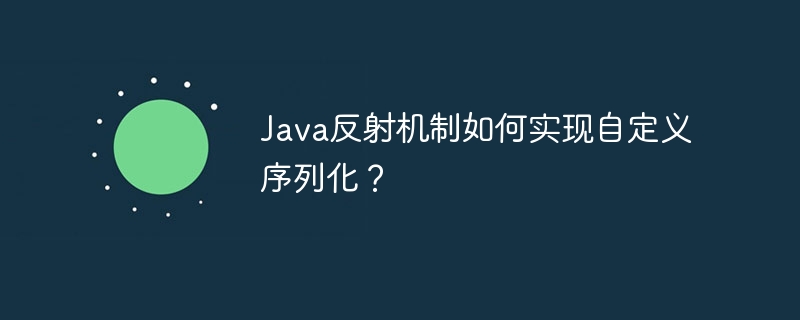Home >Java >javaTutorial >How does the Java reflection mechanism implement custom serialization?
How does the Java reflection mechanism implement custom serialization?
- 王林Original
- 2024-05-01 21:36:02452browse
Through the reflection mechanism, custom serialization can be achieved: create a custom serializer class, obtain class metadata, traverse fields and write data, and finally reconstruct the object. In a practical case, custom serialization is implemented by setting the accessibility of private fields through reflection and writing field values.

Java reflection mechanism: a powerful tool for implementing custom serialization
Introduction
Java The reflection mechanism provides powerful capabilities for introspection and manipulation of classes and objects. In custom serialization scenarios, the reflection mechanism plays a crucial role as it allows us to flexibly read and write object state.
Overview of Reflection Mechanism
The reflection mechanism essentially allows a Java program to access and modify its classes and objects at runtime. It provides classes such as Class, Field, and Method that can be used to obtain information about the structure and behavior of classes and objects.
Custom serialization uses reflection mechanism
In order to use reflection mechanism to implement custom serialization, we need to follow the following steps:
- Create a custom serializer class: This class will contain the logic to convert the object to a byte array and reconstruct the object from the byte array.
-
Get the metadata of a class using
Class: This will allow us to access the fields and methods of the class. -
Iterate over fields and write data: Using the
Fieldclass, we can iterate over the fields of an object and write their values into a byte array. - Reconstructing the object: When reconstructing the object from the byte array, we use the reflection mechanism to create the new object and set its fields.
Practical case
Let us take an example to understand how to use the reflection mechanism to implement custom serialization:
import java.io.ByteArrayInputStream;
import java.io.ByteArrayOutputStream;
import java.io.IOException;
import java.io.ObjectInputStream;
import java.io.ObjectOutputStream;
import java.lang.reflect.Field;
import java.lang.reflect.Modifier;
public class CustomSerializer {
private static byte[] serialize(Object obj) throws IOException {
ByteArrayOutputStream byteStream = new ByteArrayOutputStream();
ObjectOutputStream out = new ObjectOutputStream(byteStream);
// 获取类元数据
Class<?> clazz = obj.getClass();
// 遍历私有字段
Field[] fields = clazz.getDeclaredFields();
for (Field field : fields) {
if (Modifier.isTransient(field.getModifiers()) || Modifier.isStatic(field.getModifiers())) {
continue;
}
// 设置字段的可访问性
field.setAccessible(true);
// 写入字段值
out.writeUTF(field.getName());
out.writeObject(field.get(obj));
}
out.flush();
return byteStream.toByteArray();
}
private static Object deserialize(byte[] data) throws IOException, ClassNotFoundException {
ByteArrayInputStream byteStream = new ByteArrayInputStream(data);
ObjectInputStream in = new ObjectInputStream(byteStream);
// 反射获取类元数据
String className = in.readUTF();
Class<?> clazz = Class.forName(className);
Object obj = clazz.newInstance();
// 遍历字段并设置值
while (true) {
String fieldName = in.readUTF();
if (fieldName.equals("")) {
break;
}
Field field = clazz.getDeclaredField(fieldName);
field.setAccessible(true);
field.set(obj, in.readObject());
}
return obj;
}
public static void main(String[] args) {
Person person = new Person("John", 30);
try {
byte[] serializedData = serialize(person);
Person deserializedPerson = deserialize(serializedData);
System.out.println("反序列化后的对象: " + deserializedPerson);
} catch (Exception e) {
e.printStackTrace();
}
}
}Conclusion
By using the reflection mechanism, we can create a custom serializer to flexibly control the serialization and deserialization process of objects. This method is especially suitable for situations where you need to serialize fields that you do not want to be directly accessible to the outside world (such as fields with access modifier private).
The above is the detailed content of How does the Java reflection mechanism implement custom serialization?. For more information, please follow other related articles on the PHP Chinese website!

